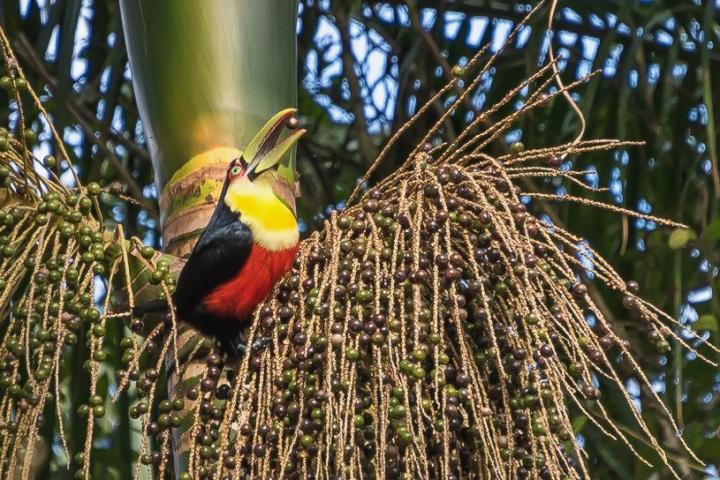Analysis of Atlantic Rainforest fragments shows how extinction of animal species, habitat loss and forest fragmentation affect networks of ecological interactions

Credit: Pedro Jordano
Research conducted in recent decades has shown how the destruction of forests brings about a decline in species diversity. A research group in Brazil led by scientists at São Paulo State University (UNESP) has now reported the findings of an investigation into how landscape changes caused by deforestation, habitat loss and fragmentation lead directly to the loss not only of species but also of their ecological interactions. The report is published in Biotropica and features on the journal’s cover. The study was supported by São Paulo Research Foundation – FAPESP.
“In ecology, we know a lot about species-area relationships but little or almost nothing about the relationship between species interactions and loss of area. Our study used ecological networks to find out how seed dispersal interactions respond to loss of area and landscape fragmentation. Shrinkage of forest fragments leads to a loss of ecological interactions that are important to the functioning of forests and the maintenance of biodiversity,” said Carine Emer, first author of the article, produced while she was a postdoctoral fellow in the Conservation Biology Laboratory (LABIC) of the Bioscience Institute (IB-UNESP) in Rio Claro, with funding from FAPESP.
The study was part of the project “Ecological consequences of defaunation in the Atlantic Rainforest”, supported by FAPESP and led by Mauro Galetti, a professor at IB-UNESP.
The researchers compiled data from 16 studies of plant-frugivore interactions in different fragments of the Atlantic Rainforest biome selected to form a gradient of human disturbance inferred from the size of each forest remnant. They focused on the interactions between plants and seed-dispersing birds because these animals are considered essential to constant forest regeneration. They concluded that the smaller the forest fragment the smaller the number of species living there and the fewer the interactions that are able to persist.
Forests and interactions
The largest and best conserved forest in the study was in Intervales State Park in the south of São Paulo State, with 42,000 hectares. It had the highest species diversity (81 frugivores and 185 fruit-bearing plants) and the most plant-seed disperser interactions (1,100 or 3.65 per species).
At the opposite end of the gradient was a six-hectare fragment that has been regenerating for a little over eight years in Piracicaba, with a far smaller number of frugivorous birds (28 species) interacting with only a few fruit-bearing plant species (6). Thus 169 seed disperser interactions were recorded, corresponding to only 1.47 per species.
In the former area, one bird species dispersed the seeds of three to four plant species. In the latter, it dispersed no more than two.
“The first to disappear are the larger birds, which are essential to disperse plant species with large seeds. This loss isn’t just numerical. It’s also functional, directly influencing the forest regeneration process,” Emer said. “In the medium to long term, plants with large seeds that lose their main dispersers tend to disappear from the landscape and become limited to larger, better conserved areas. The fragmented forest becomes poorer numerically and functionally. The only birds that remain are small species whose functional role is to disperse plant species with small seeds. In other words, we lose the ecological function of large seed dispersal. This can change our forests forever.”
Another article published previously by the group, also with Emer as lead author, showed that interactions involving large species are lost in forest fragments of less than 10,000 hectares. It also highlighted the importance of small generalist bird species that disperse the small seeds of equally generalist plants, maintaining connectivity in a fragmented landscape. In other words, Emer noted, “the Atlantic Rainforest is currently connected by interactions involving generalist birds that disperse plant species adapted to disturbed environments.”
Besides larger species, fragmentation also has an adverse effect on what are known as specific interactions. Thus a plant species dispersed by one or only a few bird species, for example, is more at risk of extinction than another species whose fruit is eaten by several different bird species.
The research line also includes a study published last year in the prestigious journal Science Advances, in which the group estimated in millions of years the loss to the evolutionary history of seed dispersal in the Atlantic Rainforest due to the disappearance of large birds.
“The Atlantic Rainforest has dwindled to only about 12% of its original area, and most of this is small forest fragments,” Emer said. “There is great diversity of seed dispersal interactions in the fragments we analyzed, with most occurring in only one or two fragments. These interactions correspond to millions of years of evolution. Species with different evolutionary trajectories interact in the present and are increasingly restricted to a few areas. In sum, we’ve reached a threshold beyond which we can’t afford any more losses. Each and every fragment of Atlantic Rainforest corresponds to millions of years of unique evolutionary history that must be conserved.”
###
About São Paulo Research Foundation (FAPESP)
The São Paulo Research Foundation (FAPESP) is a public institution with the mission of supporting scientific research in all fields of knowledge by awarding scholarships, fellowships and grants to investigators linked with higher education and research institutions in the State of São Paulo, Brazil. FAPESP is aware that the very best research can only be done by working with the best researchers internationally. Therefore, it has established partnerships with funding agencies, higher education, private companies, and research organizations in other countries known for the quality of their research and has been encouraging scientists funded by its grants to further develop their international collaboration. You can learn more about FAPESP at http://www.
Media Contact
João Carlos Silva
[email protected]
55-113-838-4351
Original Source
http://agencia.
Related Journal Article
http://dx.




